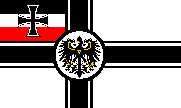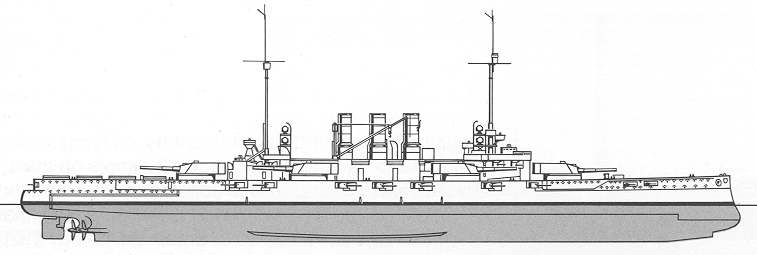
SCHLACHTSCHIFFE
Post-war Targets - SMS Helgoland, Ostfriesland, Thüringen, and Oldenburg

Mounting the larger 305mm (12") gun in the same six turret hexagonal layout as SMS Nassau, the SMS Helgoland and her sisters could be distinguished from other German dreadnoughts by her triple funnels, a design throw-back reminiscent of the pre-dreadnoughts SMS Deutschland and SMS Blücher.
Active throughout the war, the Helgoland's saw action in just about every major naval operation of the war. At Jutland they stood in the line, receiving minimal damage (Helgoland and Oldenburg each received 1 hit) and were ready for action within a week, except Ostfriesland which struck a mine while returning and was out of action until late July, 1916.
After the war they were given to the various Allies as prizes. Helgoland went to Britain who used it for various experiments before scrapping her. Ostfriesland was given to the United States and used in the famous U.S. Army Air Corp bombing tests run by General Billy Mitchell. Thüringen went to France and was used as a target ship for the French fleet. Oldenburg was given to Japan who promptly sold it for scrapping in Germany.
Like the Nassau class, the Helgoland's were driven by triple-expansion steam engines, but the RMA had been testing turbines on the light cruiser SMS Lübeck since 1904. Finally realizing that turbines were the way to go, they were incorporated into the next class of German dreadnoughts, SMS Kaiser.
PHOTOS
SMS Helgoland
SMS Ostfriesland
SMS Thüringen
SMS Oldenburg
SPECIFICATIONS
Project Name: Ersatz Siegfried (Helgoland) | Ersatz Oldenburg (Ostfriesland) | Ersatz Beowulf (Thüringen) | Ersatz Frithiof (Oldenburg)
Builder: Howaldtswerke, Kiel | Imperial Dockyard, Wilhelmshaven | AG 'Weser', Bremen | F Schichau, Danzig
Laid Down: November 11, 1908 | October 19, 1908 | November 2, 1908 | March 1, 1909
Launched: September 25, 1909 | September 30, 1909 | November 11, 1909 | June 30, 1910
Commissioned: August 23, 1911 | August 1, 1911 | September 10, 1911 | May 1, 1912
Sunk: Ostfriesland sunk by U.S. Army bombers during testing, July 21, 1921
Scrapped: Helgoland at Morecambe, 1921; Thüringen at Gavres-Lorient 1923-33; Oldenburg at Dordrecht, 1921
Displacement: 22,808 tonnes (designed) / 24,700 tonnes (maximum)
Dimensions (meters): 167.20 (overall) x 28.50 x 8.94
Dimensions (feet): 551.76 (overall) x 94.05 x 29.50
# of Shafts: 3
# of Blades: 4, 5.1m diameter
# of Rudders: 2 (side by side)
Max Speed/Range: 20.8 kts / 5,500 nm at 10 kts
Main Battery: Twelve 305mm (12")/50 caliber - 6 dual turrets
Secondary Battery: Fourteen 150mm (5.9")/45 caliber - single casement mounts
Anti-Torpedo Boat / Anti-Aircraft Battery: Fourteen 88mm (3.5")/45 caliber - single mounts
Torpedo Tubes: Six 50cm tubes (all underwater - one bow, one aft, two mounted on each side- one just forward of "Anton" turret, one aft of "Dora")
Complement: 42 officers and 1027 enlisted (as designed)
LINKS TO OTHER WEB-SITES
Naval Weapons of the World German Naval Guns
Naval Weapons of the World Pre-World War II German Torpedoes
German Kriegsmarine Encyclopedia - Click on "Hochseeflotte"
Back to Schlachtschiffe.
Back to Home.